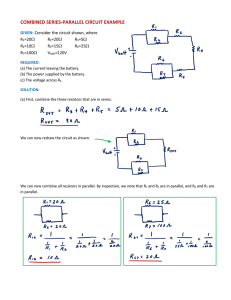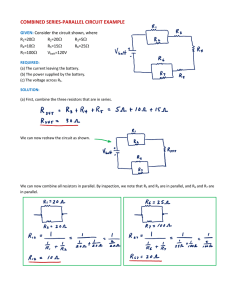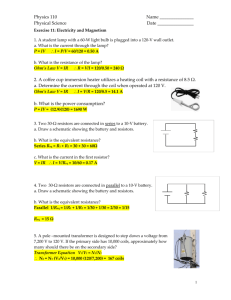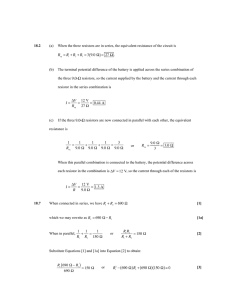4. Series and Parallel Resistance Circuits
advertisement
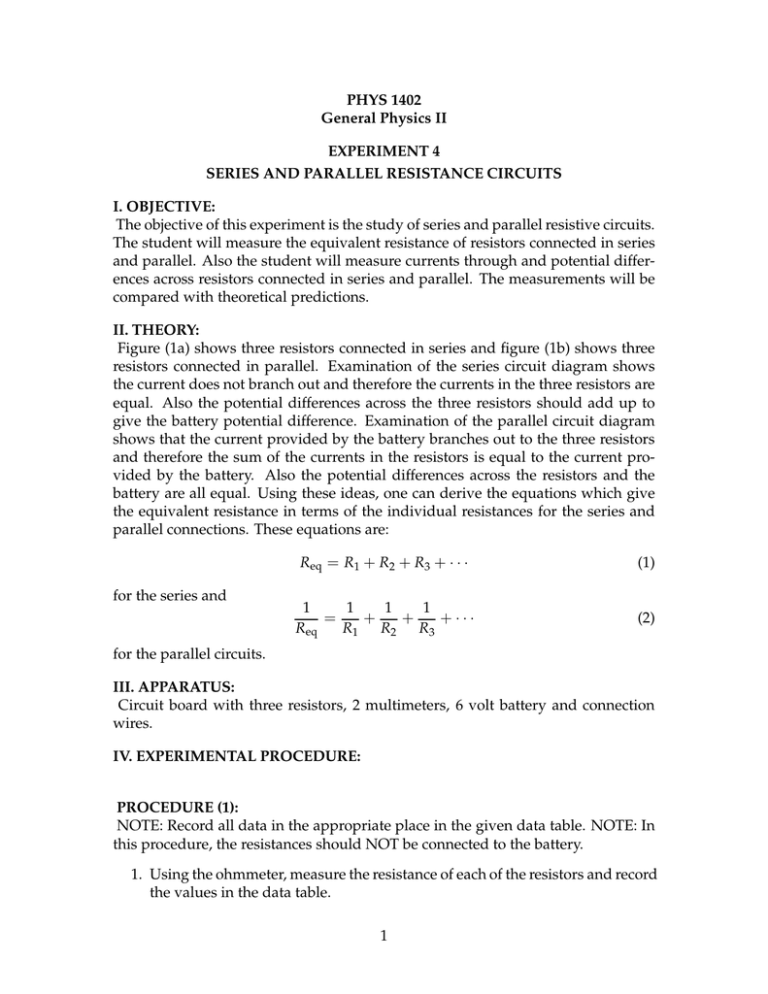
PHYS 1402 General Physics II EXPERIMENT 4 SERIES AND PARALLEL RESISTANCE CIRCUITS I. OBJECTIVE: The objective of this experiment is the study of series and parallel resistive circuits. The student will measure the equivalent resistance of resistors connected in series and parallel. Also the student will measure currents through and potential differences across resistors connected in series and parallel. The measurements will be compared with theoretical predictions. II. THEORY: Figure (1a) shows three resistors connected in series and figure (1b) shows three resistors connected in parallel. Examination of the series circuit diagram shows the current does not branch out and therefore the currents in the three resistors are equal. Also the potential differences across the three resistors should add up to give the battery potential difference. Examination of the parallel circuit diagram shows that the current provided by the battery branches out to the three resistors and therefore the sum of the currents in the resistors is equal to the current provided by the battery. Also the potential differences across the resistors and the battery are all equal. Using these ideas, one can derive the equations which give the equivalent resistance in terms of the individual resistances for the series and parallel connections. These equations are: for the series and Req = R1 + R2 + R3 + · · · (1) 1 1 1 1 = + +··· + Req R1 R2 R3 (2) for the parallel circuits. III. APPARATUS: Circuit board with three resistors, 2 multimeters, 6 volt battery and connection wires. IV. EXPERIMENTAL PROCEDURE: PROCEDURE (1): NOTE: Record all data in the appropriate place in the given data table. NOTE: In this procedure, the resistances should NOT be connected to the battery. 1. Using the ohmmeter, measure the resistance of each of the resistors and record the values in the data table. 1 2. Connect R1 and R2 in series and measure their equivalent resistance. 3. Connect R1 , R2 and R3 in series and measure their equivalent resistance. 4. Connect R1 and R2 in parallel and measure their equivalent resistance. 5. Connect R1 , R2 and R3 in parallel and measure their equivalent resistance. Procedure (2): Series Connection R3 Ammeter R1 R2 R3 R2 R1 A Battery Battery + - + Figure (1b): Resistors in Parallel Figure (1a): Resistors in Series 1. Connect R1 , R2 and R3 in series to a 6-volt battery as shown in Figure (1a). 2. Using a voltmeter, measure the potential difference across each of the resistors and the battery. 3. Insert the ammeter at the appropriate points in the series circuit and measure the current passing through each of these points. Procedure (3): Parallel Connection 1. Connect R1 , R2 and R3 in parallel to a 6-volt battery as shown in Figure (1b). 2. Using a voltmeter, measure the potential difference across each of the resistors and the battery. 3. Insert the ammeter at the appropriate points in the parallel circuit and measure the current passing through each of the resistors and the current provided by the battery. You are done with the experimental procedure. 2 ANALYSIS: 1. In the series circuit, compare the battery potential difference Vbatt. to the sum VR1 + VR2 + VR3 by calculating the percent difference Vbatt − VR + VR + VR 2 3 1 (3) % diff = ! Vbatt + VR1 + VR2 + VR3 2 Are the two quantities within 5% of each other? 2. In the series circuit, compare the currents through the resistors. Are they within 5% of each other? 3. In the parallel circuit, compare the potential difference across each of the resistors and the battery. Are they within 5% of each other? 4. In the parallel circuit, compare Ibatt. , the total current provided by the battery, to the sum of the currents through the three resistors IR1 + IR2 + IR3 by calculating the percent difference. Ibatt − IR + IR + IR 2 3 1 (4) % diff = ! Ibatt + IR1 + IR2 + IR3 2 Are the two quantities within 5% of each other? 5. Using the data collected in procdeures (2) and (3), apply Ohm’s law to calculate the values of the resistances and the equivalent in each of the series and parallel cicuits and enter your results in Tables (3) and (4) respectively. 6. Calculate the % difference between the measured equivalent resistances and the ones you calculated from Ohm’s law. 7. Write a conclusion summarizing your results. Comment on the success of this experiment. Explain any percent differences which are larger than 10%. Is your result consistent with theoretical predictions? What do you think are the two most important sources of error? 3 Experiment (4) Data Table Individual Resistors R1 = R2 = R3 = Series Connection R1 and R2 R1 , R2 and R3 Measured Req Calculated Req % Difference Parallel Connection R1 and R2 R1 , R2 and R3 Measured Req Calculated Req % Difference 4 Experiment (4) Data Table Series Connection Potential Difference Electric Current V I (Volts) (mA) Resistance (Ω ) VR1 = IR 1 V R2 = R 2 = IR 2 V R3 = R 3 = IR 3 VR1 = IR 1 = R1 = VR2 = IR 2 = VR3 = IR 3 = Vbatt = Ibatt = Req = VR1 + VR2 + VR3 = XXXXX XXXXX Vbatt = Ibatt Parallel Connection Potential Difference Electric Current V I (Volts) (mA) Resistance (Ω ) VR1 = IR 1 V R2 = R 2 = IR 2 V R3 = R 3 = IR 3 VR1 = IR 1 = R1 = VR2 = IR 2 = VR3 = IR 3 = Vbatt = Ibatt = Req = XXXXX IR 1 + IR 2 + IR 3 = XXXXX 5 Vbatt = Ibatt


